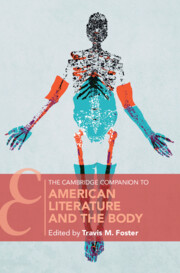Book contents
- The Cambridge Companion to American Literature and the Body
- The Cambridge Companion to American Literature and the Body
- Copyright page
- Contents
- Contributors
- Chronology of Publications and Events
- Acknowledgments
- Introduction
- Part I Genres
- 1 Bodies in Early US-Atlantic Theater
- 2 Sentimentalism and the Feeling Body
- 3 Slavery, Disability, and the Black Body/White Body Complex in the American Slave Narrative
- 4 Monstrous Bodies of the American Gothic
- 5 Bodies at War
- 6 Decolonizing the Body in Multiethnic American Fiction
- 7 Science Fiction’s Humanoid Bodies of the Future
- 8 Contemporary North American Transgender Literature
- Part II Critical Methodologies
- Further Reading
- Index
- Cambridge Companions To …
2 - Sentimentalism and the Feeling Body
from Part I - Genres
Published online by Cambridge University Press: 30 July 2022
- The Cambridge Companion to American Literature and the Body
- The Cambridge Companion to American Literature and the Body
- Copyright page
- Contents
- Contributors
- Chronology of Publications and Events
- Acknowledgments
- Introduction
- Part I Genres
- 1 Bodies in Early US-Atlantic Theater
- 2 Sentimentalism and the Feeling Body
- 3 Slavery, Disability, and the Black Body/White Body Complex in the American Slave Narrative
- 4 Monstrous Bodies of the American Gothic
- 5 Bodies at War
- 6 Decolonizing the Body in Multiethnic American Fiction
- 7 Science Fiction’s Humanoid Bodies of the Future
- 8 Contemporary North American Transgender Literature
- Part II Critical Methodologies
- Further Reading
- Index
- Cambridge Companions To …
Summary
Sentimental literature of the nineteenth century depicts the struggles of errant young women as they attempt to achieve self-control and comply with normative ideals of feminine conduct. Religious piety often figures centrally in these efforts, as sentimental heroines learn to imitate Christ in their pursuit of self-mastery and acquire moral instruction through the study of scripture. Sentimentalism’s preoccupation with spiritual matters, however, did not preclude an interest in corporeal matters, and sentimental writers afford particular attention to the body. Focused principally on depicting female development – and sustained by women writers and readers alike – sentimentalism attended to the female body in particular and warned of the special dangers that it posed, whether through its susceptibility to seduction or through its capacity to instill vanity in worldly young women. Sentimentalism characterized the female body as an especial hazard in need of protection, and, through the repeated depiction of the perils that may befall the defenseless female body, sentimental texts often assumed a public pedagogic role in teaching female readers to exercise caution and avoid unnecessary danger.
- Type
- Chapter
- Information
- Publisher: Cambridge University PressPrint publication year: 2022

